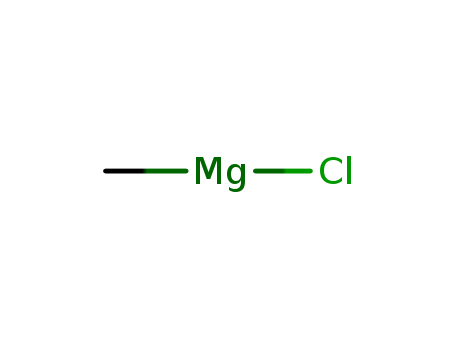Your Location:Home > Products > Organic Chemistry > Methylmagnesium chloride


CasNo: 676-58-4
MF: CH3 Cl Mg
Appearance: dark brown solution
|
Hazard |
Flammable, dangerous fire and explosionrisk. |
|
|
|
|
General Description |
Methylmagnesium chloride is a Grignard reagent that exhibits higher reactivity toward carbonyl groups compared to dimethylmagnesium, as demonstrated in reactions with various carbonyl compounds. It is commonly used in organometallic reactions, such as cross-coupling and β-fluoride elimination processes, where it serves as a methylating agent or enhances reaction efficiency. Its reactivity is influenced by solvent choice and the presence of other organometallic species, making it a versatile reagent in synthetic chemistry. |
|
Definition |
ChEBI: Methylmagnesium chloride is an alkylmagnesium halide and a one-carbon compound. available as a solutionin tetrahydrofuran. |
InChI:InChI=1/CH3.ClH.Mg/h1H3;1H;/q;;+1/p-1/rCH3Mg.ClH/c1-2;/h1H3;1H/q+1;/p-1
The invention discloses a method for pre...
A simple protocol for performing chromiu...
An acid-labile ester monomer of spirocyc...
α, β-Unsaturated acids of the formula ST...
methylene chloride

methylmagnesium chloride
| Conditions | Yield |
|---|---|
|
With magnesium; In tetrahydrofuran;
|
|
|
With magnesium; In solid matrix; at -258.2 ℃;
|
|
|
With magnesium; lithium chloride; In tetrahydrofuran; at 0 - 20 ℃; Inert atmosphere;
|
|
|
With iodine; magnesium; In dibutyl ether; at 40 ℃; for 1h; Solvent; Inert atmosphere;
|
methylene chloride

methylmagnesium chloride
| Conditions | Yield |
|---|---|
|
With diethyl ether;
|
methylene chloride
(1RS,2SR)-(+/-)-1,2-diphenyl-1,2-propandiol
(1RS,2RS)-(+/-)-1,2-diphenyl-1,2-propandiol
2,4,5-Trimethyl-3-acetyl-pyrrole
1,1,3,3-Tetramethyldisiloxane